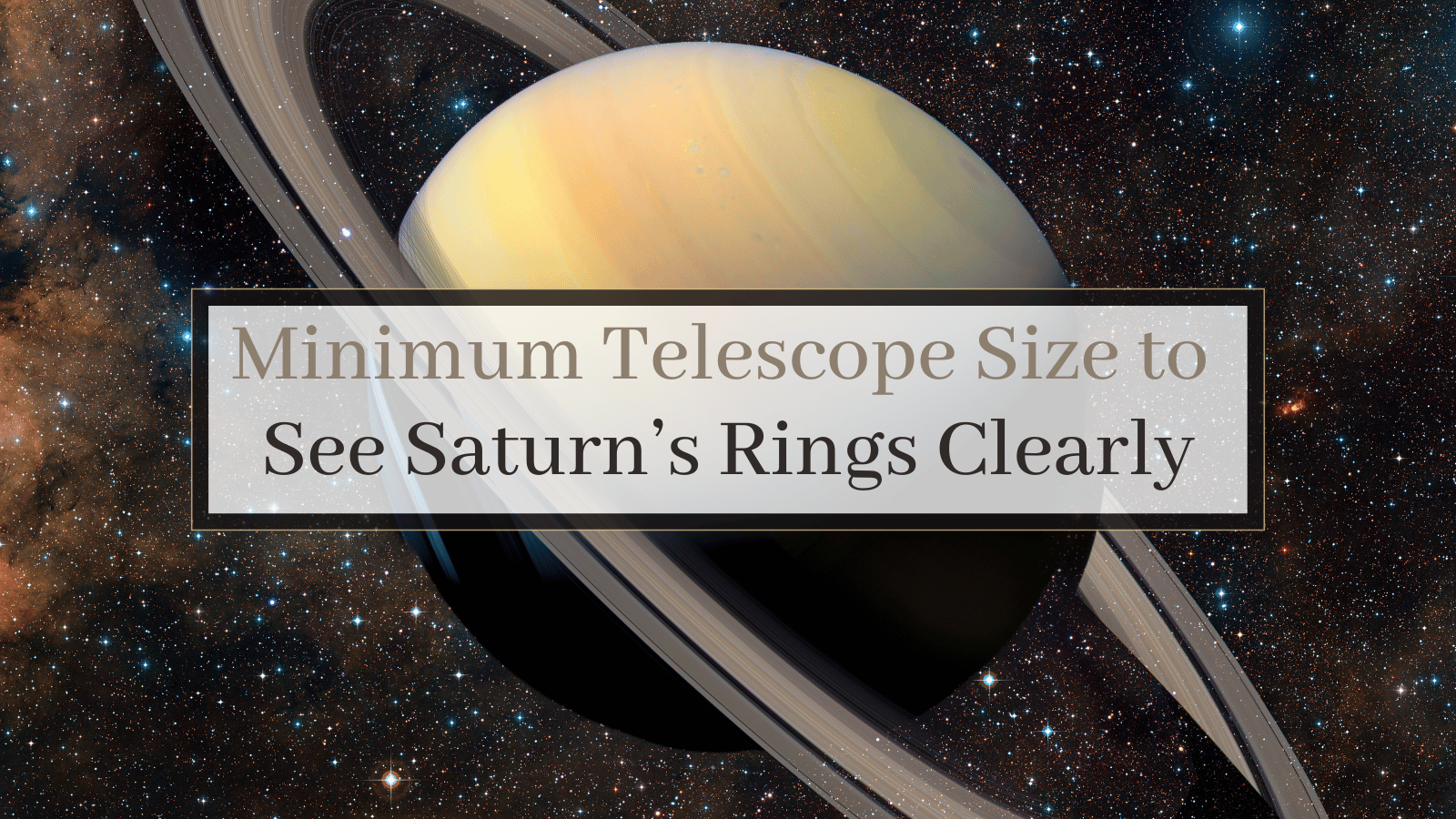Saturn, with its breathtaking rings, is one of the most mesmerizing sights in our night sky. If you’re new to astronomy, you might be asking yourself: What size telescope do I need to see those rings clearly? Well, you’re in the right place!
In this post, we’re diving into expert tips and insights to help you choose the perfect telescope for an awe-inspiring view of Saturn's rings. Whether you're just starting out or looking to upgrade, we've got all the information you need to make your stargazing experience unforgettable.
Understanding Telescope Specifications
Before we dive into the specifics of telescope sizes, let's break down a few key terms that will help you make an informed choice:
- Aperture: This is the diameter of the telescope's primary lens or mirror. It's crucial because it determines how much light your telescope can gather, directly impacting the brightness and clarity of the objects you observe.
- Focal Length: This measures the distance from the telescope’s main optical element (lens or mirror) to the point where it forms an image. It influences the magnification and field of view of your telescope.
- Magnification: This indicates how much larger the telescope can make an image appear. It's calculated by dividing the focal length of the telescope by the focal length of the eyepiece you're using.
When it comes to viewing Saturn's rings, aperture is the key factor. A larger aperture means your telescope can collect more light, providing a clearer and more detailed view of those breathtaking rings.
Minimum Telescope Size for Viewing Saturn’s Rings
To see Saturn’s rings, you'll want a telescope with at least a 60mm (2.4 inches) aperture. This size can give you a decent view, though the details might be limited. Here are some excellent 60mm - 90mm aperture options under $200:
- National Geographic 76mm Compact Reflector: This lightweight and portable telescope is perfect for beginners, offering clear views of celestial objects with its 76mm aperture and user-friendly design.
- National Geographic CF700SM 70mm Refractor: A high-quality, beginner-friendly telescope with a 70mm aperture and a 400mm focal length, ideal for observing the moon, planets, and other celestial wonders.
- Explore Scientific FirstLight 90mm f/5.5 Doublet Refractor: Featuring a 90mm aperture and a user-friendly Alt-Az mount, this telescope provides clear and sharp images, suitable for both beginners and experienced stargazers.
- National Geographic 70mm Silver Carbon Fiber Refractor: A sleek and portable telescope with a 70mm aperture and durable carbon fiber design, delivering crisp, clear views of the night sky.
- National Geographic StarApp70: Equipped with a 70mm aperture, this user-friendly telescope is perfect for beginners and comes with an astronomy app to enhance your stargazing experience.
- Explore FirstLight 80mm f/8 Refractor: With an 80mm aperture, this versatile and portable telescope is ideal for both terrestrial and celestial observations, offering crisp and clear views with its high-quality optics and sturdy mount.
While these smaller telescopes can show you Saturn’s rings, keep in mind that more detail comes with larger apertures.
Enhancing Your Viewing Experience
Want to get the best possible view of Saturn’s rings with your telescope? Here are some tips to help you maximize your stargazing experience:
- Quality Eyepieces: Investing in high-quality eyepieces can significantly improve your viewing experience. Plössl eyepieces, for instance, provide sharp and clear images, enhancing the details you can see. However, Explore Scientific's argon-purged waterproof eyepieces will provide much more immersive views.
- Filters: Using filters can enhance contrast and reduce glare, making Saturn’s rings more distinct. A yellow filter, in particular, can help highlight the details in the rings.
- Proper Focusing: Take your time to achieve precise focus. Even small adjustments can drastically improve the clarity of your view. Patience is key here!
- Observing Conditions: Aim to observe in areas with dark skies and minimal light pollution. Stable atmospheric conditions (good seeing) are also crucial for a clear view. This combination will greatly enhance the quality of what you see through your telescope.
Additionally, consider using a Barlow lens to increase magnification without sacrificing image quality. Just be cautious not to over-magnify, as it can lead to a blurry image. The right balance will give you a sharper and more detailed view of Saturn’s stunning rings.
Expert Opinions and User Experiences
Experts generally agree that a 60mm telescope is a good starting point for viewing Saturn's rings, but for more detailed views, they recommend telescopes with an aperture of 80mm to 100mm.
Jamie Carter, an experienced astronomy writer, suggests that while a 50mm (2-inch) refractor can show Saturn's rings, for noticeably better views, a 102mm (4-inch) telescope is preferable. Real detail in the rings becomes evident with a 125mm (5-inch) telescope (T3).
Alan MacRobert from Sky & Telescope notes, "Saturn has a more three-dimensional appearance than any other object in the sky; at least that’s how it looks to me with a 6-inch scope on a night of fine seeing." He emphasizes that while a small telescope can show the rings, a larger aperture will reveal more intricate details such as the Cassini Division and the elusive Encke Division under excellent viewing conditions (Sky & Telescope).
User Experiences:
- John W.: “I started with a 70mm telescope, and the first time I saw Saturn’s rings was magical. Upgrading to a 100mm later gave me much more detail.”
- Sarah L.: “Using my 60mm refractor, I could see the rings, but they appeared as a thin line. With a bit of patience and the right conditions, it’s still a rewarding experience.”
These real-life testimonials highlight how even small telescopes can provide a glimpse of Saturn’s rings, while larger apertures enhance the viewing experience by revealing more details.
Beyond the Minimum: When to Consider Upgrading
Starting with a small telescope is fantastic, but if you get hooked (and you probably will), upgrading to a larger telescope can significantly enhance your stargazing experience. Here’s why:
- Increased Detail: Larger apertures, such as 150mm (6 inches) or more, can reveal the Cassini Division (the gap between Saturn's rings) and intricate surface details on the planet itself. This makes your observations much richer and more satisfying.
- Better Optics: Higher-quality optics can reduce chromatic aberration and improve overall image quality, providing sharper and clearer views.
- Versatility: Larger telescopes aren't just for Saturn—they’re also excellent for observing other celestial objects, like nebulae, galaxies, and star clusters, expanding your stargazing repertoire.
Recommended Upgrades (over 100mm aperture):
- National Geographic NG114mm Newtonian: With a 114mm aperture and equatorial mount, this telescope provides clear and detailed views of celestial objects, making it ideal for both beginner and intermediate astronomers.
- Explore FirstLight 114mm f/4.3 Newtonian: This model features a 114mm aperture and a sturdy equatorial mount, offering precise tracking and exceptional views of celestial objects.
- Explore FirstLight 102mm f/6.5 Doublet Refractor: Equipped with a 102mm aperture, this telescope delivers sharp and detailed views of celestial objects and comes with an easy-to-use mount, perfect for beginner astronomers.
- Explore FirstLight 127mm f/15 Mak-Cassegrain: This compact and highly portable telescope features a 127mm aperture, providing clear and detailed views of celestial objects, ideal for amateur astronomers.
- Explore Scientific 10" f/5 Hybrid Truss Tube Dobsonian: Boasting a large 10-inch (254mm) aperture, this telescope offers stunning views of deep sky objects and planetary details with exceptional clarity and brightness.
Upgrading your telescope will not only enhance your views of Saturn but also open up a universe of other astronomical wonders for you to explore.
Image Examples


Your Journey to Saturn's Rings
So, there you have it! To see Saturn’s rings clearly, a 60mm telescope is the minimum starting point. If you’re after more detail and a richer viewing experience, opting for a larger aperture will make a significant difference.
Remember, enhancing your stargazing experience is all about using quality accessories, observing under optimal conditions, and practicing patience. If you find yourself falling in love with this hobby (and chances are, you will), upgrading to a larger telescope can elevate your stargazing to a whole new level, revealing even more wonders of the night sky.
Happy observing!

